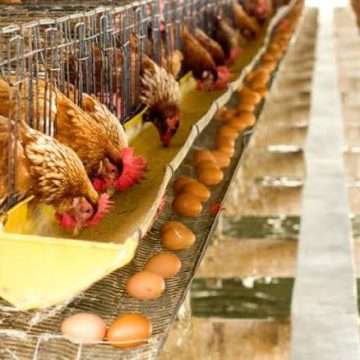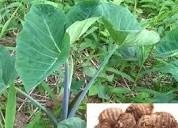The term cocoyams are used to refer collectively to members of the genus Colocasia and the genus Xanthosoma which are grown for food in many parts of Africa, especially the wetter parts.
They are grown in small plots, often intercropped with food or cash crops.
They are volunteer crops in many places and can be classified as minor crops considering the level of attention given to them by farmers.
The plants of both species are similar but the long and stout petiole of Colocasia is attached to the leaf blade at some point in the middle of the blade, not to its edge.
The plants of Xanthosoma are larger and the leaves are saggitate with triangular basal lobes.
They are more prolific in growth and earlier than Colocasia. Some authorities refer to Colocasia as old cocoyam and Xanthosoma as new cocoyam.
Origin of Cocoyam
Taro originated in south-central Asia from where it spread to west Africa while Tannia originated in Central and South America and was first cultivated there.
It was introduced to Africa in the nineteenth century, much later than taro. Hence, it is sometimes called ‘new cocoyam’.
About three-quarters of world production comes from Africa and there is probably a greater production of tannia than of taro.
Ecology of Cocoyam
Cocoyams are crops of the humid tropics. They require an annual rainfall of at least 2500mm.
Cocoyams are warm-weather plants and do best when temperatures are above 21°C.
They are able to tolerate shady conditions better than most other crops. Taro is able to tolerate shady waterlogged conditions but tannia requires well-drained soil.
Cocoyams prefer soil pH of 5.5-6.5 and are able to tolerate saline soils. In Nigeria, it is grown in most parts and as far north as the Sudan zone.
Botany of the Crop
The plants grow up to 2m tall with a short underground stem (corm) which consists of one or more large central corms and a variable number of small side tubers (cormels) developing vegetatively from the parent corm.
The corms vary in size with varieties. The surface of the corm is rough and is marked by a number of rings representing the nodes of the stem.
Buds are present on the upper rings. The roots are fibrous and shallow.
The aerial portion of cocoyams consists mainly of leaves. Each leaf is attached to the corm by means of a long petiole, which is flared out and indented at the end where it is attached to the corm.
Large air space exists in the petiole and in the major veins of the lamina so that the petiole and veins have a rather spongy texture.
The shape and venation of the lamina, and the mode of attachment of the petiole to it, are major distinguishing features between taro and tannia.
The leaf of tannia is saggitate with a deep indentation x which divides the base of the lamina into two lobes.
The petiole is attached at the junction of the margins of these two lobes. From the point of the margins of these two lobes.
From the point of attachment of the lamina, a thick mid-rid runs to the apex of the leaf, while two large veins run to the basal lobes; the general venation is reticulate.
For taro, the leaf is more circular in shape and the basal lamina lobes are less sharply demarcated than tannia.
Moreover, the attachment of the petiole is somewhere in the middle of the lamina (I.e. peltate attachment) and not at the margin where the two lobes meet.
Several main veins radiate from the point of attachment of the petiole, but as with tannia, the general venation is reticulate.
Natural flowering in cocoyam is relatively rare. The inflorescence is a spadix and consists of a stout peduncle, a large yellowish bract called the spathe, and the central axis to which numerous small flowers are attached.
The spathe partially unsheaths the basal portion of the spadix.
The flowers on the spadix are unisexual, the female flowers occurring at the basal (proximal) portion of the spadix and the make flowers occurring at the distal part.
Some sterile flowers occur between the regions of female and male flowers. The fruit is a berry.
Cultural practices of Cocoyam
The tops of the corm or whole cormels are used for propagation. They are planted at a spacing of 60x60cm when the rains are reliable.
The best time to plant cocoyam is between march and July but most farmers in the south plant between May and June.
Depending on location, planting is done either in heaps, ridges, or flatbeds.
The plants may be mulched to conserve moisture and control weeds.
Fertilizer can be applied in form of NPK 15.15.15 at 200-300 kg/ha about one month after planting.
Because of the crop’s high demand for potassium, N.P.K.Mg, 12.12.17.2, can also be applied.
Organic manure, where available can be used up to 15t/ha.
Weeds can also be controlled manually and weeding should be as shallow as possible to avoid damaging the shallow root system.
Various herbicides have proved effective for weed control in cocoyams. A pre-emergence application of prometryne (1.2kg/ha) or atrazine (3kg/ha) can control weeds in the first few months after planting.
Harvesting
Cocoyams are ready for harvest after 7-11 months, but it doesn’t take long for cocoyam to germinate. The crop is harvested by digging around the base, cutting mature tubers, replacing the soil, and leaving the plants to continue growing. Further harvests may be made later.
Yields Expectation of the crop
Yields of less than 5t/ha are obtained under farmers’ conditions but with improved practices, yields of over 25t/ha are possible.
Cocoyam Storage methods
Cocoyams do not store well and many farmers simply avoid having to store by leaving the crop in the field and harvesting only as needed.
Curing at 30°C with 95-100% relative humidity is effective in reducing weight loss and decay.
When properly cured, they can be stored at ambient temperature by packing in perforated plastic bags.
For prolonged storage, cocoyams should be kept at about 7°C at a relative humidity of 85%.
They can also be stored on open platforms for a few weeks.
Chemical composition
Cocoyams corm is composed of 70-80% water, 20-25% starch, and 1.5-3% protein.
It also contains significant amounts of vitamin C, thiamine, riboflavin, niacin, and carotene.
Benefits of Cocoyam
- For human consumption by cooking, frying, roasting, or baking.
- Processed into flour by peeling, slicing, drying the slices, and milling the dried slices. The flour is used for various food preparations.
- The young leaves are used as vegetables in some places. Cooking removes the calcium oxalate, which causes acidity in the leaves and tubers.
- The leaves, corms, and cormels can be used as animal feed.
Diseases affecting Cocoyams
Leaf blight is caused by Phythoothora colocasiae especially in wet weather. This can be controlled with fungicides, e.g. dithane.
The use of resistant varieties is also recommended, the disease does not attack tannia.
Soft rot, caused by several species of Pythium, attacks both taro and tannia. The pathogen exists in the soil and attacks the roots, corms, and cormels, causing them to rot.
The disease is controlled by the use of resistant varieties, by planting disease-free material, and by crop rotation.
Nematodes
Root-knot nematodes (Meloidogyne spp.) can be a problem, especially where the crop is grown continuously in the same area.
Control is by planting nematode-free materials and fumigating infected soil with nematicides such as Nemagon.







